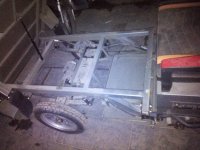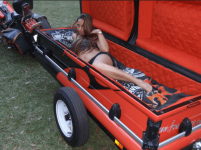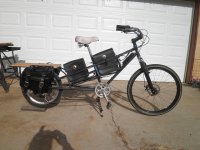joe81 said:
my questions was more about the high leverage point when using the seat post connection. when braking it will tend to lift the rear wheel and downhill + cornering is expect the tendency to move the rear wheel of the bike around. ..highly instable driving situation.. but i have no practical experience if that is only an issue in extreme situations or disturbing throughout the whole ride.
Back in the 80's I developed a seatpost-connected trailer for dragging my kids around. It handled way better than other trailers/connections I'd used previously.
But this trailer development was in Lincoln, NE USA where the landscape is very flat and the roads, while not completely paved, are pretty good to excellent.
joe81 said:
ddk said:
joe81 said:
Are brakes on the trailer mandatory on slight downhills (disk braked bike + regen at the rear wheel)?
over 4% slope I found mechanical brakes prone to overheating and failure. My 'final solution' was using regen on the trailer itself (both wheels) in addition to the (trike) brakes. Motor brakes make excellent drag brakes and are easily modulated and far more adaptable over a mechanical brake setup (done both) and the pain of connecting a cable-pull vs. an electrical connection is significant. Electrical connection is the clear winner.
joe81 said:
so you are using the two wheels of the trailer for regen and propulsion of the whole rig too?
Funny you ask. Other users on this board attempted to convince me I'd need the motors to help operate/push my setup, but I'd already developed an e-trike capable of transporting the whole mess (mass) for my
specific situation. Yet operated legally in my jurisdiction.
And...
It's all about the
specifics; specifics base the engineering involved to meet
minimum needs for maximum requirements. (hence the term, YMMV, is always invoked)
With solar panels, unpredictable in operation, along with other battery-charge sources, the basic issues involve 'power harvesting', 'battery capacity' etc. (oxymoron warning) and it is always better (at least in my mind) to keep things (especially very complex things) as simple as possible.
-Therefore, no, I did not use the motors for anything other than brakes, using slightly depleted battery packs as a power sink.
Basically I'd already built what you're proposing to do but with my specifics being different than yours
means my trikes' build met my needs and me, not being familiar with
exactly what you require can not answer your questions
exactly (or even generally).
Also, I have little experience traveling in China (closer to 'none').
joe81 said:
i've just been to the local tricycle dealers and checked out some frames..
thought of cutting a second hand one behind the battery box and attaching a trailer hitch there.
unfortunately they are mostly 48V and i already have battery and rear wheel kit for 72V on the bike..
anyway leaf springs and parking brake are a nice to have.
The specific trike I developed is found elsewhere on this forum but spans three threads and many pages, Also for reasons involving redundant, backup and emergency (limp along) systems it was far easier to use 36V motor systems. (all about KISS principles)
Basics:
I built my trike by modifying a semi-standard "granny" delta trike. Amberwoof's trike is somewhat based upon it. It's a:
-semi-recumbent delta trike with 17" high
comfortable seat , two motors; a front wheel hub motor and a mid drive through an IGH transmission.
-Simple two-point suspension (front wheel and seat)
-300W solar panels. Two 22V 150W panels that could switch between series or parallel operation.
-One panel installed on the trike. One panel installed on the trailer
-60Ah of battery in three packs packs being switchable between motor systems, charging systems and braking systems. (KISS system- a lot of DPDT 30A switches)
-Parking brakes consisting of two strips of velcro holding the hand brake levers closed (LOL-KISS)
After I'd built and tested this thing for a couple of weeks with many, many road miles, things changed, requiring/forcing me to abandon the project.





